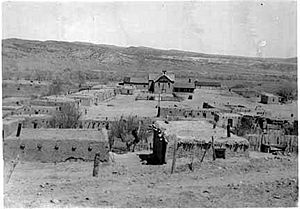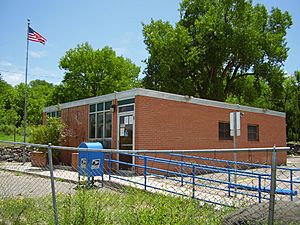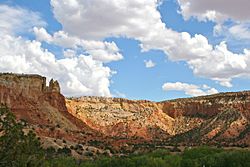Abiquiú, New Mexico facts for kids
Quick facts for kids
Abiquiú, New Mexico
Péshú:bú'; Gultɨdda
|
|
|---|---|

The adobe Santo Tomás Church in Abiquiú
|
|

Location of Abiquiú within New Mexico
|
|
| Country | United States |
| State | New Mexico |
| County | Rio Arriba |
| Area | |
| • Total | 0.95 sq mi (2.47 km2) |
| • Land | 0.95 sq mi (2.47 km2) |
| • Water | 0.00 sq mi (0.00 km2) |
| Elevation | 6,172 ft (1,881 m) |
| Population
(2020)
|
|
| • Total | 181 |
| • Density | 189.73/sq mi (73.28/km2) |
| Time zone | UTC−7 (Mountain (MST)) |
| • Summer (DST) | UTC−6 (MDT) |
| ZIP Code |
87510
|
| FIPS code | 35-00310 |
| GNIS feature ID | 2584043 |
Abiquiú (![]() i/ˈæbɪkjuː/, Spanish pronunciation: [aβiˈkju]) is a small community in northern New Mexico, in the southwestern United States. It's located in Rio Arriba County, about 53 miles (85 km) north of Santa Fe. In 2010, about 231 people lived there. Abiquiú has one elementary school, which is part of the Española Public Schools.
i/ˈæbɪkjuː/, Spanish pronunciation: [aβiˈkju]) is a small community in northern New Mexico, in the southwestern United States. It's located in Rio Arriba County, about 53 miles (85 km) north of Santa Fe. In 2010, about 231 people lived there. Abiquiú has one elementary school, which is part of the Española Public Schools.
The name Abiquiú means "wild chokecherry place" in the Tewa language. It is also known as Santo Tomás de Abiquiú. In the 1700s, the Spanish government gave land here to a group of people called genízaros. They helped protect the area from other tribes like the Comanche.
Abiquiú was also one of the homes of the famous American artist Georgia O'Keeffe. She lived there from 1929 until 1984. Her home and studio are still in Abiquiú. She also owned land at the nearby Ghost Ranch. Many of her paintings show the beautiful landscapes around Abiquiú.
Contents
History of Abiquiú
Abiquiú was first settled in 1742. About 24 Tewa Pueblo families, led by a priest named Francisco Delgado, moved there. These Tewa people had returned to New Mexico after living with the Hopi people in what is now Arizona. The Spanish colonists wanted to settle Abiquiú to help protect their lands from groups like the Apache, Comanche, and Navajo. Abiquiú was on the northern edge of the Spanish settlements in New Mexico.
In 1747, the Comanche raided the area. They took 23 women and children captive, which made people temporarily leave Abiquiú. These captives were often traded or sold among different groups.
The Genízaro Settlement
In 1754, New Mexico's governor, Tomás Vélez Cachupín, tried to make the settlement stronger. He gave land to 34 genízaro families. In return, they agreed to play a big part in defending the frontier. Abiquiú was one of the first genízaro settlements in New Mexico.
Genízaros were Native Americans from different tribes. They often became part of Spanish society after being captured in wars or traded. They had fewer rights under Spanish law. Getting land grants on the frontier was a main way for them to own land. Abiquiú became a very important genízaro community. Many people living there today still celebrate their genízaro heritage.
Peace and Trade
Later in the 1700s, peace was made between New Mexico, the Comanche, and the Ute. An annual trade fair was held in Abiquiú. Many Native American people came to trade, especially the Utes. They traded things like deer skins for horses and tools. Settlers also bought or helped free captive children from Native American groups. Ute bands often camped near Abiquiú during the winter.
In the 1840s, the peace with the Utes broke down. About 1,000 Utes came to Abiquiú with complaints. Some Utes were killed in this conflict. Peace was restored in 1849 by the U.S. government. The U.S. had recently taken over New Mexico after the Mexican–American War.
Land Rights and Modern Times
Throughout the 1800s, the people of Abiquiú worked hard to keep their land. They had been granted about 16,000 acres (6,500 ha) in 1754. In 1894, a U.S. court confirmed their right to the land. In 1969, even more land, which had been part of a National Forest, was given back to the community. Today, Abiquiú is a popular place for tourists. Some people from other parts of the U.S. have also moved there.
Old Spanish Trail
Abiquiú was the starting point for an important trade route called the Old Spanish Trail. The first journey on this route was led by Antonio Armijo from Santa Fe. In 1829, he left Abiquiú with 60 men and pack animals. They carried blankets and other goods to trade for mules in Alta California.
Armijo's group left Abiquiú on November 7, 1829. They reached San Gabriel Mission in 86 days, on January 31, 1830. He returned using the same route in 56 days. Armijo wrote down details about his journey every day. These reports were short, listing dates and stopping places. They helped others understand the route.
Climate in Abiquiú
The climate in Abiquiú is a semi-arid climate. This means it's generally dry, but not a desert.
| Climate data for Abiquiu Dam (1991–2020 normals, extremes 1957–present). Elevation: 6,380 ft (1,940 m) | |||||||||||||
|---|---|---|---|---|---|---|---|---|---|---|---|---|---|
| Month | Jan | Feb | Mar | Apr | May | Jun | Jul | Aug | Sep | Oct | Nov | Dec | Year |
| Record high °F (°C) | 62 (17) |
70 (21) |
85 (29) |
86 (30) |
94 (34) |
101 (38) |
101 (38) |
99 (37) |
95 (35) |
90 (32) |
77 (25) |
67 (19) |
101 (38) |
| Mean maximum °F (°C) | 55.8 (13.2) |
61.0 (16.1) |
70.8 (21.6) |
77.0 (25.0) |
85.9 (29.9) |
94.2 (34.6) |
96.5 (35.8) |
93.5 (34.2) |
89.2 (31.8) |
81.1 (27.3) |
67.9 (19.9) |
57.9 (14.4) |
97.3 (36.3) |
| Mean daily maximum °F (°C) | 42.0 (5.6) |
47.0 (8.3) |
55.9 (13.3) |
63.3 (17.4) |
72.8 (22.7) |
83.8 (28.8) |
87.5 (30.8) |
85.1 (29.5) |
78.7 (25.9) |
67.0 (19.4) |
53.9 (12.2) |
43.3 (6.3) |
65.0 (18.3) |
| Daily mean °F (°C) | 29.9 (−1.2) |
34.4 (1.3) |
42.3 (5.7) |
49.0 (9.4) |
58.2 (14.6) |
68.5 (20.3) |
72.9 (22.7) |
70.9 (21.6) |
64.1 (17.8) |
52.2 (11.2) |
40.6 (4.8) |
31.2 (−0.4) |
51.2 (10.7) |
| Mean daily minimum °F (°C) | 17.7 (−7.9) |
21.8 (−5.7) |
28.6 (−1.9) |
34.8 (1.6) |
43.7 (6.5) |
53.3 (11.8) |
58.3 (14.6) |
56.8 (13.8) |
49.5 (9.7) |
37.4 (3.0) |
27.3 (−2.6) |
19.0 (−7.2) |
37.4 (3.0) |
| Mean minimum °F (°C) | 6.3 (−14.3) |
9.5 (−12.5) |
18.2 (−7.7) |
25.2 (−3.8) |
33.3 (0.7) |
43.7 (6.5) |
50.5 (10.3) |
51.0 (10.6) |
40.4 (4.7) |
26.2 (−3.2) |
16.3 (−8.7) |
6.8 (−14.0) |
1.4 (−17.0) |
| Record low °F (°C) | −25 (−32) |
−17 (−27) |
−8 (−22) |
8 (−13) |
19 (−7) |
28 (−2) |
37 (3) |
39 (4) |
30 (−1) |
10 (−12) |
−8 (−22) |
−18 (−28) |
−25 (−32) |
| Average precipitation inches (mm) | 0.41 (10) |
0.34 (8.6) |
0.58 (15) |
0.79 (20) |
0.80 (20) |
0.62 (16) |
1.65 (42) |
1.75 (44) |
1.19 (30) |
0.89 (23) |
0.50 (13) |
0.54 (14) |
10.06 (256) |
| Average snowfall inches (cm) | 2.8 (7.1) |
2.0 (5.1) |
1.6 (4.1) |
0.4 (1.0) |
0.0 (0.0) |
0.0 (0.0) |
0.0 (0.0) |
0.0 (0.0) |
0.0 (0.0) |
0.1 (0.25) |
0.6 (1.5) |
3.0 (7.6) |
10.5 (27) |
| Average precipitation days (≥ 0.01 inch) | 4.4 | 4.9 | 5.1 | 5.4 | 6.4 | 4.9 | 11.2 | 12.1 | 7.5 | 6.4 | 4.5 | 5.0 | 77.8 |
| Average snowy days (≥ 0.1 inch) | 1.4 | 1.4 | 0.7 | 0.4 | 0.0 | 0.0 | 0.0 | 0.0 | 0.0 | 0.0 | 0.3 | 1.6 | 5.8 |
| Source: NOAA | |||||||||||||
Population and Schools
| Historical population | |||
|---|---|---|---|
| Census | Pop. | %± | |
| 2020 | 181 | — | |
| U.S. Decennial Census | |||
As of 2020, the population of Abiquiú was 181 people.
Children in Abiquiú attend schools that are part of Española Public Schools. The main public high school for the area is Española Valley High School.
Abiquiú in Movies and TV
The beautiful canyons and mountains around Abiquiú are often seen in movies. Many Westerns have been filmed here. Some of these include:
- Red Dawn (1984)
- Silverado (1985)
- Lonesome Dove (1989)
- City Slickers (1991)
- Wyatt Earp (1994)
- The Wild Wild West (1999)
- 3:10 to Yuma (2007)
- No Country For Old Men (2007)
- Indiana Jones and the Kingdom of the Crystal Skull (2008)
- Cowboys & Aliens (2011)
- The Lone Ranger (2013)
The area was also featured in the TV series Earth 2.
An episode of the TV show Breaking Bad is titled "Abiquiu". In this episode, characters visit a Georgia O'Keeffe art exhibition, likely the one in Abiquiú.
Places to Visit Nearby
- Abiquiu Lake
- Dar al-Islam (organization)
- Echo Amphitheater
- Georgia O'Keeffe Home and Studio
- Ghost Ranch, which has the Ruth Hall Museum of Paleontology
- Monastery of Christ in the Desert
- Santa Rosa de Lima, New Mexico, a ghost town
Famous People from Abiquiú
- Julian A. Chavez (1808–1879), a rancher and politician in Los Angeles, California.
- José Manuel Gallegos (1815–1875), a priest and politician who represented New Mexico in the U.S. House of Representatives.
- Georgia O'Keeffe, a very famous American artist.
See also
 In Spanish: Abiquiú para niños
In Spanish: Abiquiú para niños





